Control of scale insects in Florida citrus utilizes native and introduced exotic natural enemies, including predators, parasites, and pathogens. Under most conditions, predators and parasites suppress scale pest populations to a level where chemical intervention is unnecessary. In situations where natural enemies do not provide the necessary control, integrated pest management (IPM) is used since it minimizes negative effects on natural enemies. Increases in scale insect populations involve multiple factors including: a) disruption of biological control by weather; b) infestation of areas by scale insects where natural enemies do not exist; and c) disruption of natural enemies by the repeated use of non-selective pesticides.
When scale insects are not controlled by biological or chemical means, high populations damage leaves, fruit, twigs, branches, and/or tree trunks. Usually scale populations increase slowly over a period of weeks or months on isolated trees or areas within a grove. Some of the scale insects produce honeydew on which sooty mold will form. Sooty mold can reduce the photosynthetic capability of the leaves and delay color break, thereby reducing external fruit quality.
If and when chemical intervention is needed, close inspection of the scale of concern is required to determine the level of healthy and parasitized scale insects present. By turning over scale on the plant parts, the level of parasitism can be estimated and appropriate action taken. Chemical treatment should be applied when plant injury begins to occur and parasites, predators, or pathogens are absent. For maximum suppression of scales, the young mobile nymphal stages, referred to as crawlers, should be targeted as they are more susceptible to control than the eggs, settled larger nymphal, or adult stages of the scales.
Armored Scale
Purple Scale - Lepidosaphes beckii (Newman)
The armor of the adult female scale is 2 to 3 mm long, purple to dark brown, elongated, and usually curved (Fig. 1). The armor of the male is much shorter and more slender than the female. The eggs are found under the scale cover and after hatching, the pearl white crawlers are less than 0.25 mm in length. Infestations may occur at any time, but are usually highest during the spring. Purple scales prefer a tree with a dense canopy and are found on leaves, twigs, and fruit. In most cases chemical control is not required as biological control by a parasitic wasp, Aphytis lepidosaphes Compere and the ladybeetle, Chilocorus stigma Say, provide adequate control. Other predators and parasitic fungi have also been found attacking the purple scales in Florida.
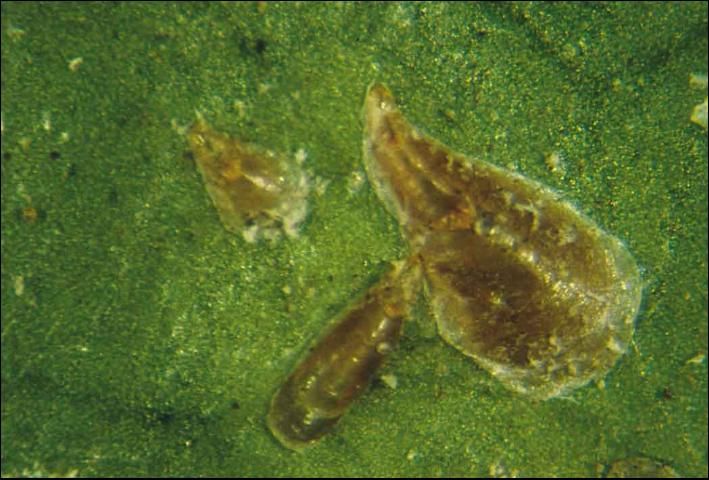
Credit: UF/IFAS CREC
Glover Scale - Lepidosaphes gloveri (Packard)
Glover scale is sometimes referred to as long scale. The scale covering is brown, elongated, narrow in width and about 3 mm in length (Fig. 2). The glover scale is similar to the purple scale and can be found in mixed populations. Glover scales infest leaves, twigs, woody bark, and fruit. When found on woody bark, they orient with the grain of the bark and parallel to one another and are frequently difficult to detect (Fig. 3). Glover scales are usually kept under biological control by Aphytis parasitic wasps.
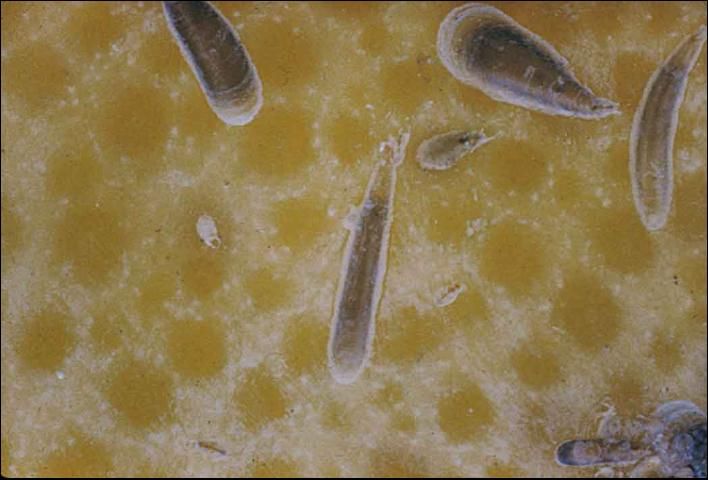
Credit: UF/IFAS CREC
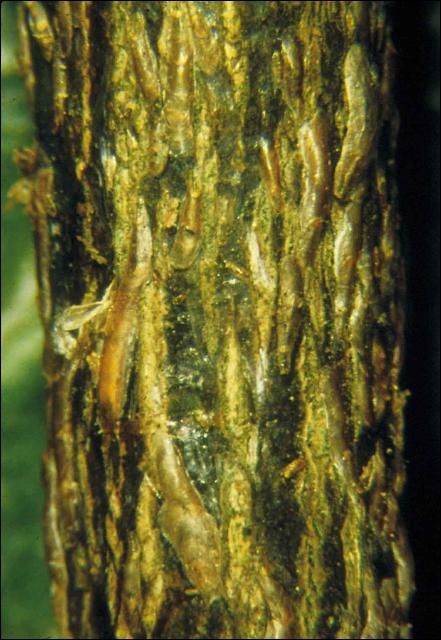
Credit: UF/IFAS CREC
Fern Scale - Pinnaspisas pidistrae (Signoret)
Scale bodies of the males are white, elongated and about 1.5 to 2.25 mm long whereas the females are brown (Fig. 4). Colonies normally consist of one or two females and up to 30 males. They are found on leaves and fruit of citrus but not on large limbs or trunks. This scale has a wide host range and is found throughout Florida, but never causes economic damage to citrus.

Credit: UF/IFAS CREC
Citrus Snow Scale - Unaspis citri (Comstock)
The adult female is 1.5 to 2.25 mm long. The female armor is shaped like an oyster shell, with a central longitudinal ridge. It is brownish purple to black, with a grey border. Beneath the outer covering is an elongated orange-yellow membranous scale body. The immature male scale armor is white with parallel sides and three longitudinal sections, one central with two marginal ridges (Fig. 5). The adult male is winged and light yellow. The crawlers are oblong and light orange to reddish in color.
Citrus snow scales primarily attack the trunk and large limbs of the tree, but can be found on leaves, twigs and fruit at high population levels. All scale insect stages are present throughout the year. Prolonged feeding on the tree trunk appears to be associated with splitting of trunk bark. This symptom is more prevalent on young trees compared to mature trees.
Predators commonly found attacking other armored scales have also been found feeding on citrus snow scale. Native and introduced strains of Aphytis lingnanensis Compere and Encarsia spp. are common biological control agents.

Credit: UF/IFAS CREC
Florida Red Scale - Chrysomphalus aonidum (L.)
Florida red scale has circular armor made up of three concentric rings. The color is dark reddish brown with a conspicuous light brown center (Fig. 6). The adult female is about 2.0 to 2.2 mm in diameter and produces bright yellow eggs which are deposited under the scale armor in groups of approximately 10 eggs. Eggs generally hatch in 24 to 48 hours.The adult male is small, gnat-like and free flying. Florida red scale infests only the leaves, green twigs, and fruit (Fig. 7).
Florida red scale is under biological control by the introduced parasite, Aphytis holoxanthus (DeBach). Some additional insect predators feed on Florida red scale.
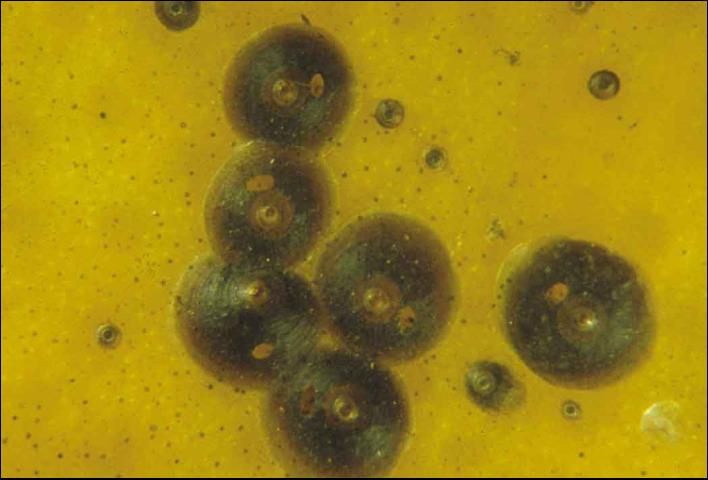
Credit: UF/IFAS CREC

Credit: UF/IFAS CREC
Chaff Scale - Parlatoria pergandii Comstock
The scale covering is irregularly rounded to oblong, 1 to 1.75 mm in length, and very flat (Fig. 8). It conforms to the shape of the area where it begins development and will develop successive layers resembling grain chaff. The color is brownish to grayish. The female body, eggs, and crawlers are purple in color. Immature and male scales resemble the female but are smaller in size. Chaff scale is found on bark, leaves, and fruit. When fruit is infested, the areas around the scale remains green at maturity. Chaff scale can also be found under the calyx of the fruit. When found on the leaves, the midrib is a favored site for settling. Chaff scales are difficult to remove from the fruit surface in normal packinghouse operations. Effective biological control is provided by the parasitic wasp, Aphytis hispanicus (Mercet).
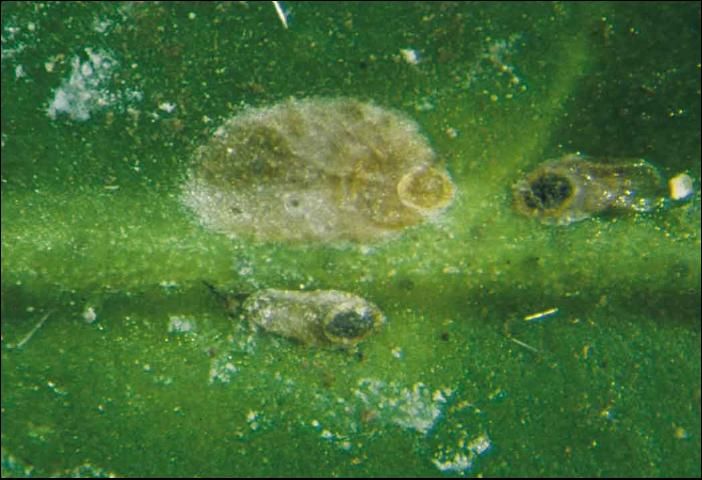
Credit: UF/IFAS CREC
Unarmored (Soft) Scale
Caribbean Black Scale - Saissetia neglecta DeLotto
The female is 3 to 5 mm long and brown to black in color. When mature it has a very tough shell which is nearly circular or hemispherical in shape (Fig. 9). Ridges along the outer scale body form an "H" pattern. Immature scales have a lighter scale covering and lack the "H" in the early instars. Adult males are free flying. Crawlers are about 0.34 mm long and are light brown. Scales are found on young fruit stems and twigs. Caribbean black scales secrete prolific amounts of honeydew onto the stems and fruit, which later develops sooty mold that will lower fruit grade, if not washed off. A wasp, Scutellista cyanea (Motscholsky), is an egg predator that provides acceptable biological control. When inspecting mature scale for parasitism, one will frequently notice a circular emergence hole in the scale covering caused by the wasp.
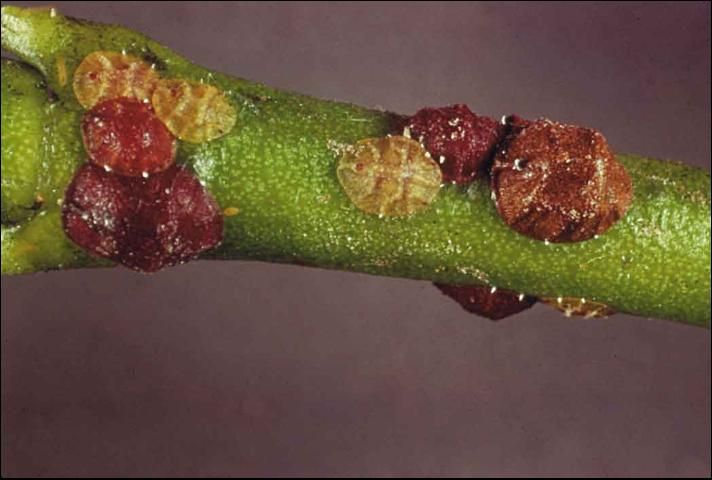
Credit: UF/IFAS CREC
Cottonycushion Scale - Icerya purchasi Maskell
The scale is broadly oval and bright reddish brown in color. The body is covered with waxy secretions and has a white cottony fluted egg sac attached to the posterior of the mature female body (Fig. 10). The egg sac can be twice as long as the scale body and contain 500 to 800 reddish eggs. Eggs hatch in a few days in warm weather or up to two months in cooler weather. Newly hatched nymphs are bright red with dark antennae. Total length of the scale, including the egg sac, is 10 to 15 mm.
Early immature stages of the scale cause the greatest damage on citrus while extracting plant sap during feeding along the leaf midrib and on green twigs. Later stages migrate to the larger twigs, where they feed and secrete honeydew from which sooty mold grows. Heavy infestations may result in defoliation, twig dieback, and fruit drop. Cottonycushion scale can be found on many species of ornamental plants as well as on citrus.
Populations are highest in the drier months of fall and winter. The ladybeetle, Rodolia cardinalis (Mulsant), both as larvae and adults, is the main predator of the cottony cushion scale.
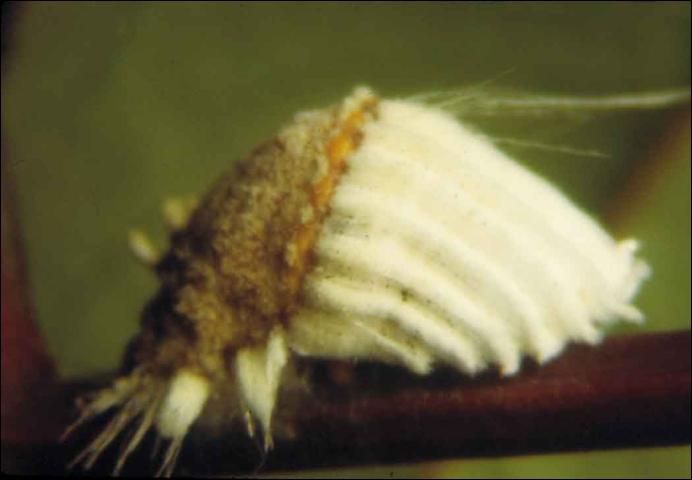
Credit: UF/IFAS CREC
Soft Brown Scale - Coccus hesperidum L.
The scale body is flat and oval, light brown to yellowish in color with brown stippling, and 2.5 to 4 mm long (Fig. 11). This scale gives birth to pale yellow crawlers. Males are uncommon. Soft brown scales secrete large amounts of honeydew and the adjoining foliage becomes heavily coated with sooty mold. On occasions young citrus trees can be killed by high populations of soft brown scale from feeding and honeydew production. Scale feeding on older trees results in reduced tree vigor, twig dieback, reduced yields, and lower fruit grades due to heavy sooty mold. Soft brown scale can be found infesting a wide range of ornamental plants.
The scale is heavily parasitized by several different species of parasitic wasps.

Credit: UF/IFAS CREC
Florida Wax Scale - Ceroplastes floridensis Comstock
The adult female is covered with a thick layer of soft wax, about 2 to 4 mm in length and 1 to 3.5 mm in width. Males are unknown in this species. Florida wax scale is highly convex, somewhat angular, and oval. The color is white, sometimes with a pinkish cast, becoming dirty white with age (Fig 12). Eggs are pink to dark red and are found under the scale's wax covering. Crawlers are pink, migrate away from under the female's wax covering, settle, and begin to extract sap from leaves or twigs. Young scales have a similar wax covering. Large amounts of honeydew are secreted by this species. Immature stages of Florida wax scales are found on the leaves and twigs with older stages frequently found on twigs and branches. Leaf populations are aligned with the leaf midrib. Florida wax scales are seldom found in large numbers due to presence of effective natural enemies.
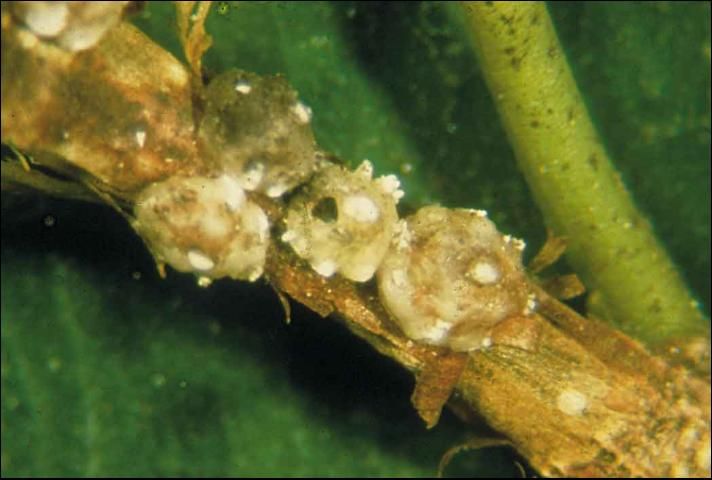
Credit: UF/IFAS CREC
These are not the only scale insects species, as there are more than 40 species of scale insects present on Florida citrus. However, these are the most commonly encountered. For more information on scales, you may wish to consult the following publications: Division of Plant Industry "Arthropods of Florida," University of Florida's SP176 "Identification of Mites, Insects, Diseases, Nutrition Symptoms and Disorders on Citrus," SP43 "Florida Citrus Production Guide," "Intergrated Pest Management Guide," and Florida Science Source's "Florida Citrus Pest Diagnostic Guide."